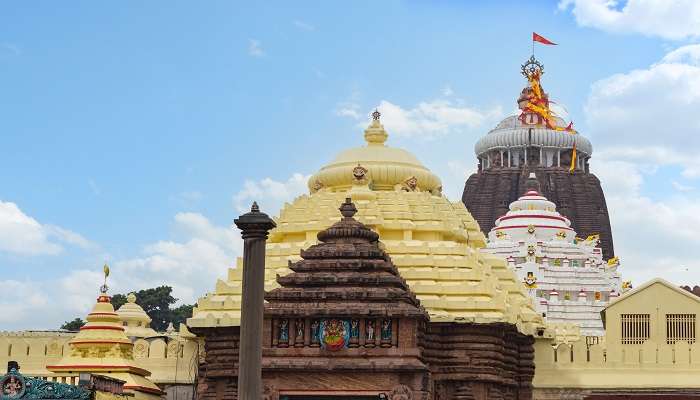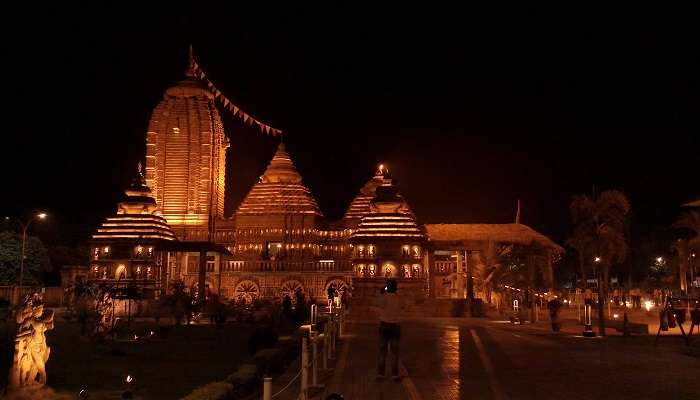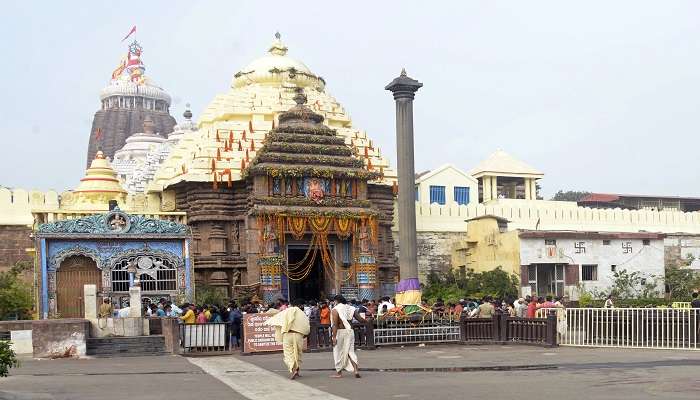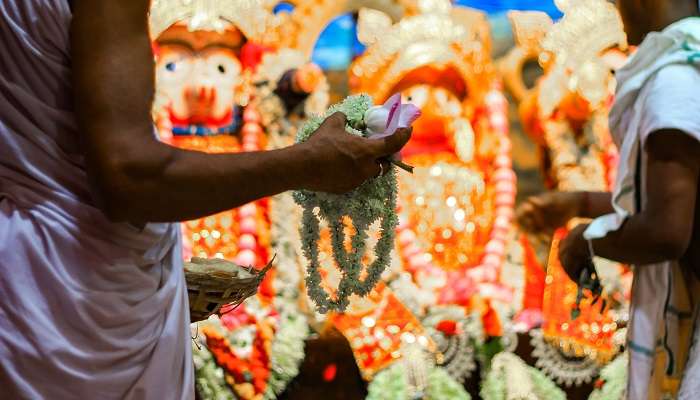Shree Jagannath Temple Puri Tour With A Guide For Devotees To Seek Blessings In 2025

The Shree Jagannath Temple Puri in Odisha is one of the most famous and sacred Hindu temples in the country. It is dedicated to Lord Jagannath who is a form of Lord Vishnu, along with his siblings Lord Balabhadra and Goddess Subhadra. The temple is not only a place of worship but also an architectural marvel that attracts millions of devotees and tourists every year. In this article, we will explore the temple’s timings, history and much more. We’ve come up with a list of all you need to know for a fruitful visit to the temple.
About Shree Jagannath Temple Puri

Odisha is known as the land of Lord Jagannath (the Lord of the Universe). The temple built in the 12th Century AD has been the epicenter of the Jagannath cult and sees pilgrims flocking the temple town of Puri from all corners of the world throughout the year. The mysticism associated with Lord Jagannath’s cult overshadows this magnificent temple’s architectural brilliance. Built on a raised platform, the gigantic temple is an architectural marvel in its own right.
The temple saw new additions to its structure till about the 16th Century AD, unlike other temples of the region. The carvings on the temples are predominantly of gods and goddesses. The entire temple complex is enclosed within two concentric walls, the Kuruma Bheda (Inner wall) and the Meghnad Pachira (Wall). The main entrance to the temple is through Singhadwara, located on the Eastern front of the temple, with three other entrances along the four cardinal directions. However, these are not architecturally aligned, indicating that the other entrances might have been created for security purposes since the temple was at the eye of the storm during the tumultuous period between the 16th and 18th century.
Must Read: Things To Do In Puri
Architecture of Jagannath Temple Puri

The Jagannatha Temple, situated in the heart of Puri, Odisha stands as a breathtaking masterpiece of Kalingan architecture. This majestic edifice is a testament to the ingenuity and artistic prowess of ancient Indian architects. Located within an inner courtyard, the temple rests on a raised platform, its grandeur commanding attention from all directions.
The temple’s architectural design seamlessly blends two distinct styles of Rekha and Pidha creating a harmonious fusion that captivates the senses. The Vimana or Deula, the sanctum sanctorum is a magnificent example of the Nagara style Rekha deula, characterized by a curvilinear tower known as the shikhara. The Jagamohana which is the porch attached to the Vimana showcases the Pidha deula style adding an intricate layer of complexity to the structure.
The Vimana, or the main sanctuary, is commonly referred to as the Garbhagriha. Its design follows the Pancha Ratha ground plan, where the vertical shape, from the base to the pinnacle of the curvilinear shikhara, is divided into five projected column-like structures, or raths, on each of the four sides. This unique architectural quality lends the Rekha deula its distinct character. Both the Vimana and the Jagamohana are divided into five principal parts along the vertical plane: the pishta or pitha (foundation), the bada (vertical wall), the gandi (curvilinear tower in the case of a Rekha deula), the pyramidal roof (in the case of a Pidha deula), and the mastaka (the crowning elements). The crowning element of the Vimana is the ‘Nilachakra,’ an eight-spoked wheel representing Lord Vishnu, crafted from Ashtadhatu and considered highly sacred.
Adjacent to the Vimana and Jagamohana are the Natamandapa (audience hall) and the Bhoga Mandapa (hall for residuary offerings), aligned in an axial east-west direction, forming a harmonious ensemble. The temple complex is further adorned with four magnificent gates – the Eastern ‘Singhadwara’ (the main gate flanked by crouching lions), the Southern ‘Ashwadwara,’ the Western ‘Vyaghra Dwara,’ and the Northern ‘Hastidwara’ – each bearing a carving of its namesake animal. The Jagannatha Temple is a masterful synthesis of architectural brilliance, religious fervour, and cultural heritage. Its harmonious blend of styles, intricate carvings, and symbolic elements create a breathtaking visual tapestry that inspires awe and reverence among visitors worldwide.
How To Reach

By Air
The nearest airport to Puri is the Biju Patnaik International Airport in the state capital, Bhubaneswar, approximately 60 kilometres (37 miles) away. Upon arrival at the airport, you have several options for reaching Puri. You can hire a taxi, take a pre-paid taxi service, or use ride-sharing services like Uber or Ola, which are readily available at the airport. The journey from the airport to Puri usually takes 1.5 to 2 hours depending on traffic conditions.
By Train
Puri is well-connected by rail, and the Puri Railway Station is one of the main railway hubs in Odisha. Trains from various major cities across India, including Delhi, Kolkata, Chennai, and Mumbai, connect to Puri. It’s advisable to check the train schedules and book your tickets in advance, especially during peak pilgrimage seasons, to secure your journey to Puri by train.
By Road
Puri is well-connected by an extensive road network, allowing for travel by road from various cities and towns in Odisha and neighbouring states. Numerous government and private bus services operate routes to Puri from nearby cities and towns. The city of Bhubaneshwar is approximately 60 km from Puri, Kolkata is 400 km and Vishakhapatnam is 500 km away. These buses provide various comfort levels and pricing, catering to different budgets and preferences. Taxis can also be hired for a more comfortable and personalized journey to Puri. Ensure that you negotiate the fare with the driver before setting out on your journey.
Suggested Read: Offbeat Places In Puri
Timings

The Jagannath Temple in Puri operates on a daily schedule that involves various rituals, and it opens and closes at different times throughout the day. Here are the general timings for visiting the temple
Morning
The temple usually opens early in the morning, around 5 AM. The morning darshan (viewing) is highly significant, and devotees often aim to be present during this time to have a glimpse of the deities. The morning rituals begin with the Mangala Aarti, which is the first form of worship offered to the deities.
Evening
The temple reopens for the evening darshan around 7 PM. The evening rituals include the Sandhya Dhupa, which is the evening meal offered to the deities.
The Temple Remains Closed During the Afternoon. After the morning darshan, the temple closes for a few hours in the afternoon, typically between 1 PM and 4 PM. During this time, the temple premises are cleaned, and preparations are made for the evening rituals.
Further Read: Bedi Hanuman Temple
Now that you have a list of things to keep in mind for your next vacation to see the Auspicious Shree Jagannath Temple in Puri make sure you plan your trip to Puri to these fabulous spots for the experience of a lifetime. Don’t miss out on these opportunities and book your tickets now!
For our editorial codes of conduct and copyright disclaimer, please click here.
Cover Image Source: Shutterstock
Frequently asked questions About Shree Jagannatha Temple Puri
What is the Significance of Jagannath Temple?
The Jagannath Temple in Puri is one of the most revered Hindu shrines dedicated to Lord Jagannath, an incarnation of Lord Vishnu. It is considered one of the Char Dham (four principal pilgrimage sites) in India and attracts millions of devotees annually.
What are the Main Deities and Festivals of the Jagannath Temple?
The main deities worshipped are Lord Jagannath, Lord Balabhadra, and Devi Subhadra. The iconic Rath Yatra (Chariot Festival) is the most famous festival celebrated annually, where the deities are taken out in a grand procession on chariots.
What are the Jagannath Temple Rituals and Timings?
The temple follows a strict set of rituals, including the famous Mahaprasad (sacred food) offering. It opens for darshan (viewing) at 5:00 AM and closes at 9:00 PM, with specific timings for various rituals.
What are the Jagannath Temple Entry Rules?
Entry to the temple is restricted based on certain rules. Non-Hindus are not allowed inside the main temple premises, and there is a specific dress code that must be followed by devotees
What are the Nearby Attractions of Puri?
Puri Beach, known for its golden sands and serene ambience, is just a short distance from the temple. Other nearby attractions include the Gundicha Temple, Loknath Temple, and the Puri Heritage Village, offering a glimpse into the local culture and traditions
People Also Read:
Temples in Odisha Tourist places in Odisha Odisha in June

Passionate Marketing Student with a flair for storytelling, eagerly embarking on a journey within the vibrant world of travel. Excited to merge analytical acumen with creative skills to elevate the editorial landscape of the travel industry.











